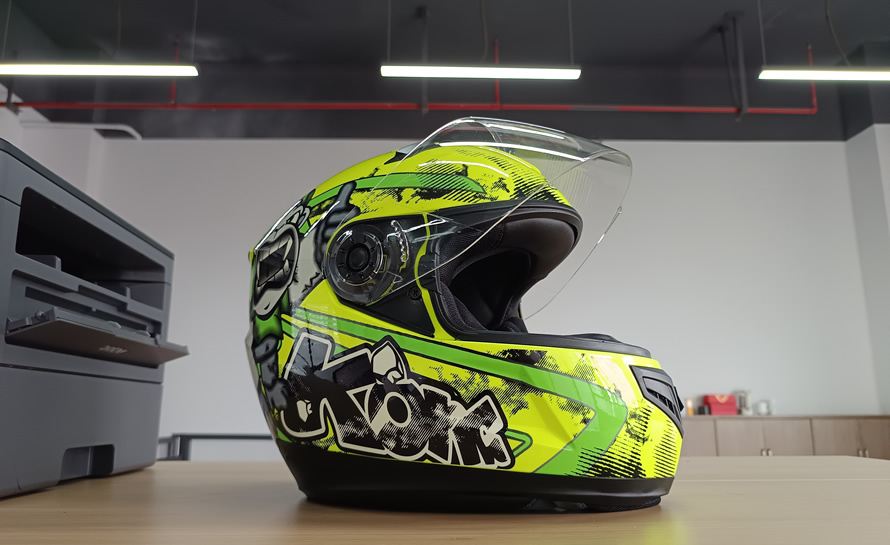Here’s a clear breakdown of DOT and ECE 22.06 certifications, including their differences and which one you should consider.

 e: DOT vs. ECE 22.06
e: DOT vs. ECE 22.06
| Feature | DOT (FMVSS 218) | ECE 22.06 |
|---|---|---|
| Governing Body | U.S. Department of Transportation (USDOT) | United Nations Economic Commission for Europe |
| Certification Process | Self-certification by manufacturer | Independent, type-approval testing by accredited labs |
| Primary Focus | Impact absorption and penetration resistance. | Broader safety, including impact, abrasion, stability, and visor quality. |
| Testing Method | Anvil test (flat and hemispherical) | Anvil test (flat, hemispherical, curbstone) |
| Impact Testing | One impact per test point. | Two impacts on the same test point to simulate a real-world multi-impact crash. |
| Roll-Off Test | No | Yes. Tests if the chin strap system prevents the helmet from rolling off the head during a crash. |
| Chin Bar Test | No dynamic test for modular/flip-up helmets. | Yes. Rigorous dynamic test for modular helmets to ensure the chin bar stays locked on impact. |
| Abrasion Resistance | No | Yes. Tests the helmet's shell material against abrasion. |
| Visor Testing | Very basic (penetration and optics) | Extensive (optics, clarity, penetration, abrasion resistance) |
| Where is it Required? | United States | Over 50 countries, including all of Europe, the UK, Japan, India, and many others. |
What it is: The minimum legal standard for helmets sold in the United States.
How it Works (The Major Flaw): It is a self-certification standard. This means the manufacturer itself tests its helmets and declares that they meet the DOT requirements. The USDOT performs random spot-checks, but the primary responsibility lies with the manufacturer.
Pros:
Legally sufficient for riding in the USA.
Generally found on a wide range of helmets, including very affordable ones.
Cons:
The self-certification process has led to instances of "DOT-only" stickers being placed on helmets that do not actually meet the standard (so-called "novelty helmets").
The testing methodology is considered outdated, focusing on high-impact energy management but lacking in other critical areas like roll-off stability and real-world multi-impact scenarios.
What it is: The European standard, widely considered the global benchmark for motorcycle helmet safety. The "22.06" is the latest version, introduced in 2022, replacing the older 22.05 standard.
How it Works (The Gold Standard): It is an independent, type-approval standard. Manufacturers must send samples to an accredited independent laboratory (like the TÜV in Germany). If the samples pass, that helmet model is "type-approved" for production. This removes the conflict of interest present in self-certification.
Key Advancements in 22.06:
Double Impact Test: Simulates a crash where a rider's head might hit the pavement more than once. This is a huge step forward in real-world testing.
Enhanced Chin Bar Test: Modular (flip-up) helmets are subjected to a severe dynamic test to ensure the chin bar mechanism doesn't fail.
Roll-Off Test: A mandrel (simulating a head) is placed in the helmet and pulled; the strap retention system must prevent the helmet from coming off. This directly addresses a common cause of head injury in crashes.
Abrasion Test: The shell material is tested for its ability to resist grinding away on pavement, which can prevent exposure of the inner liner.
Advanced Visor Tests: Includes tests for abrasion resistance to maintain clarity after a wipe-down.
For most riders, an ECE 22.06 certified helmet is the unequivocally safer choice.
The independent testing, more rigorous procedures, and focus on real-world crash scenarios (like multiple impacts and helmet roll-off) make it a more comprehensive and trustworthy standard.
However, context matters:
If you are in the USA: A DOT-certified helmet is all you legally need. However, the vast majority of high-quality helmets sold in the US are now both DOT and ECE 22.05/22.06 certified. Look for both stickers on the helmet strap or liner.
If you are in Europe or most other countries outside the US: ECE 22.06 is the legally required standard.
While DOT is a legitimate standard, ECE 22.06 represents the current pinnacle of mainstream helmet safety certification due to its rigorous, independent, and modern testing protocols.
When shopping for a helmet, prioritize models that are at least ECE 22.05 certified, and ideally the latest ECE 22.06. Seeing both DOT and ECE stickers on a helmet is very common and gives you the confidence of meeting a high global standard.
A Final Note on Other Standards: For the ultimate in protection, you may also see:
SNELL M2020 or M2015: A voluntary, very stringent standard popular in motorsports. It focuses on extreme impact protection but uses a different philosophy than ECE. Some argue its stiffer standards are less optimized for real-world street crashes compared to ECE 22.06.
FIM FRHPhe: The new gold standard for racing, even more rigorous than ECE or SNELL. It's currently found on only a few top-tier race helmets.
Your safest bet is a helmet from a reputable manufacturer that carries both DOT and ECE 22.06 certification.